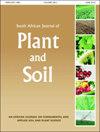埃塞俄比亚主要咖啡生产系统和地区的杂草种类组成和丰度
IF 1.1
Q3 AGRONOMY
引用次数: 2
摘要
进行了一项杂草种群调查,以评估埃塞俄比亚主要咖啡生产系统和地区杂草物种组成和丰度的可变性。使用系统采样技术中的象限计数对总共168个咖啡田进行了评估。利用每个地点杂草的频率、丰度和优势度来评估杂草的物种组成。我们共发现了35科98个杂草分类群,其中以菊科和禾本科最为丰富。最常见的杂草种类是Oplismenus hirtellus(L.)P.Beauv.、Galinsoga parviflora Cav.、。,牛膝,凤仙花。频率在40%以上。杂草种类的密度各不相同,其丰度值最高的是O.hirtellus。评估的16个地区的相似性指数在8.33%至72.73%之间,而咖啡生产系统和海拔范围的相似性指标分别在7.14%至49.49%和41.76%至68.75%之间。咖啡生产系统和土壤性质是影响研究区杂草种类分布和组成的主要解释变量。总之,咖啡生产商在设计适当的管理策略以减少咖啡农场的杂草时,应该考虑到这些变量。本文章由计算机程序翻译,如有差异,请以英文原文为准。
Weed species composition and abundance in the main coffee production systems and regions of Ethiopia
A weed population survey was carried out to assess the variability in weed species composition and abundance in the main coffee production systems and regions of Ethiopia. A total of 168 coffee fields were assessed using a quadrat count in a systematic sampling technique. Weed species composition was evaluated using frequency, abundance and dominance of species at each site. We found a total of 98 weed taxa belonging to 35 families, of which Asteraceae and Poaceae were the most abundant. The most frequent weed species were Oplismenus hirtellus (L.) P.Beauv., Galinsoga parviflora Cav., Achyranthes bidentata Blume, Impatiens balfourii Hook. F., Bidens pilosa L. and Commelina benghalensis L., with a frequency of over 40%. The density of weed species varied and the highest abundance value was recorded by O. hirtellus. Similarity indices of the 16 districts assessed ranged from 8.33% to 72.73%, while the similarity indices of the coffee production systems and altitudinal range ranged from 7.14% to 49.49% and 41.76% to 68.75%, respectively. Coffee production systems and soil properties were the main explanatory variables influencing weed species distribution and composition in the study areas. In conclusion, coffee producers should take into account these variables while designing the appropriate management strategies to curtail weeds in coffee farms.
求助全文
通过发布文献求助,成功后即可免费获取论文全文。
去求助
来源期刊

South African Journal of Plant and Soil
Agricultural and Biological Sciences-Plant Science
CiteScore
1.90
自引率
11.10%
发文量
32
期刊介绍:
The Journal has a proud history of publishing quality papers in the fields of applied plant and soil sciences and has, since its inception, recorded a vast body of scientific information with particular reference to South Africa.
 求助内容:
求助内容: 应助结果提醒方式:
应助结果提醒方式:


